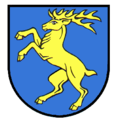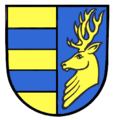Deer: Difference between revisions
| Line 32: | Line 32: | ||
The word ''hart'' is an old alternative word for "stag" (from [[Old English]] ''heorot'', "deer" – compare with modern Dutch ''hert'', also "deer"). It is not now widely used, but [[William Shakespeare|Shakespeare]] makes several references (for example in ''[[Twelfth Night]]''), punning on the sound-alike "hart" and "heart". "The White Hart" and "The Red Hart" remain common English [[public house|pub]] names, and the county [[Hertfordshire]] is thought to be named after a place where deer forded a watercourse. [[Whinfell Forest]] once contained a landmark tree called ''Harthorn''.<ref>[http://www.genuki.org.uk/big/eng/WES/zzBooks/cox1.htm ''Magna Britannica et Hibernia'']</ref> |
The word ''hart'' is an old alternative word for "stag" (from [[Old English]] ''heorot'', "deer" – compare with modern Dutch ''hert'', also "deer"). It is not now widely used, but [[William Shakespeare|Shakespeare]] makes several references (for example in ''[[Twelfth Night]]''), punning on the sound-alike "hart" and "heart". "The White Hart" and "The Red Hart" remain common English [[public house|pub]] names, and the county [[Hertfordshire]] is thought to be named after a place where deer forded a watercourse. [[Whinfell Forest]] once contained a landmark tree called ''Harthorn''.<ref>[http://www.genuki.org.uk/big/eng/WES/zzBooks/cox1.htm ''Magna Britannica et Hibernia'']</ref> |
||
your gay so just shut up |
|||
==Habitat== |
|||
<span id="doe"/> |
|||
[[Image:Muntiacus.muntjak.jpg|thumb|right|125px|[[Reeves's Muntjac]] deer]] |
|||
[[Image:Reindeer in Kebnekaise.jpg|thumb|right|[[Reindeer]] in Sweden]] |
|||
[[Image:White-tail deer.jpg|thumb|right|White-tail deer in Toronto, Canada]] |
|||
[[Image:Daněk 3.jpg|thumb|right|Fallow buck in the Czech Republic]] |
|||
[[Image:Magdalen Deer.jpg|thumb|right|The deer in the Grove of [[Magdalen College, Oxford]].]] |
|||
Deer are widely distributed, and [[hunting|hunted]], with indigenous representatives in all continents except [[Antarctica]] and [[Australia]], though [[Africa]] has only one native species, the [[Red Deer]], confined to the [[Atlas Mountains]] in the northwest of the continent. |
|||
Deer live in a variety of [[biome]]s ranging from [[tundra]] to the [[tropical rainforest]]. While often associated with forests, many deer are [[ecotone]] species that live in transitional areas between forests and thickets (for cover) and prairie and savanna (open space). The majority of large deer species inhabit temperate mixed deciduous forest, mountain mixed coniferous forest, tropical seasonal/dry forest, and savanna habitats around the world. Clearing open areas within forests to some extent may actually benefit deer populations by exposing the [[understory]] and allowing the types of grasses, weeds, and herbs to grow that deer like to eat. Additionally, access to adjacent croplands may also benefit deer. However, adequate forest or brush cover must still be provided for populations to grow and thrive. |
|||
Small species of [[brocket deer]] and [[pudú]]s of Central and South America, and [[muntjac]]s of Asia generally occupy dense forests and are less often seen in open spaces, with the possible exception of the [[Indian Muntjac]]. There are also several species of deer that are highly specialized, and live almost exclusively in mountains, grasslands, swamps, and "wet" savannas, or riparian corridors surrounded by deserts. Some deer have a circumpolar distribution in both North America and Eurasia. Examples include the [[Reindeer|caribou]] that live in Arctic tundra and taiga (boreal forests) and [[moose]] that inhabit [[taiga]] and adjacent areas. Huemul Deer ([[taruca]] and [[South Andean Deer|Chilean Huemul]]) of South America's [[Andes]] fill an ecological niche of the [[ibex]] or [[Wild Goat]], with the fawns behaving more like goat kids. |
|||
The highest concentration of large deer species in temperate [[North America]] lies in the Canadian Rocky Mountain and Columbia Mountain Regions between Alberta and British Columbia where all five North American deer species ([[White-tailed deer]], [[Mule deer]], [[reindeer|Caribou]], [[Elk]], and [[Moose]]) can be found. This region has several clusters of national parks including [[Mount Revelstoke National Park]], [[Glacier National Park (Canada)]], [[Yoho National Park]], and [[Kootenay National Park]] on the British Columbia side, and [[Banff National Park]], [[Jasper National Park]], and [[Glacier National Park (U.S.)]] on the Alberta and Montana sides. Mountain slope habitats vary from moist coniferous/mixed forested habitats to dry subalpine/pine forests with alpine meadows higher up. The foothills and river valleys between the mountain ranges provide a mosaic of cropland and deciduous parklands. The rare woodland caribou have the most restricted range living at higher altitudes in the subalpine meadows and alpine tundra areas of some of the mountain ranges. Elk and Mule Deer both migrate between the alpine meadows and lower coniferous forests and tend to be most common in this region. Elk also inhabit river valley bottomlands, which they share with White-tailed deer. The White-tailed deer have recently expanded their range within the foothills and river valley bottoms of the Canadian Rockies owing to conversion of land to cropland and the clearing of coniferous forests allowing more deciduous vegetation to grow up the mountain slopes. They also live in the aspen parklands north of Calgary and Edmonton, where they share habitat with the [[moose]]. The adjacent [[Great Plains]] grassland habitats are left to herds of [[Elk]], [[American Bison]], and [[pronghorn]] antelope. |
|||
The [[Eurasia]]n Continent (including the Indian Subcontinent) boasts the most species of deer in the world, with most species being found in Asia. Europe, in comparison, has lower diversity in plant and animal species. However, many national parks and protected reserves in Europe do have populations of [[Red Deer]], [[Roe Deer]], and [[Fallow Deer]]. These species have long been associated with the continent of Europe, but also inhabit [[Anatolia|Asia Minor]], the [[Caucasus Mountains]], and Northwestern [[Iran]]. "European" Fallow Deer historically lived over much of Europe during the Ice Ages, but afterwards became restricted primarily to the [[Anatolia]]n Peninsula, in present-day [[Turkey]]. Present-day Fallow deer populations in Europe are a result of historic man-made introductions of this species first to the Mediterranean regions of Europe, then eventually to the rest of Europe. They were initially park animals that later escaped and reestablished themselves in the wild. Historically, Europe's deer species shared their deciduous forest habitat with other herbivores such as the extinct [[Equus ferus ferus|tarpan]] (forest horse), extinct [[aurochs]] (forest ox), and the endangered [[wisent]] (European bison). Good places to see deer in Europe include the [[Scottish Highlands]], the Austrian [[Alps]], and the wetlands between Austria, Hungary, and Czech Republic. Some fine National Parks include [[Doñana National Park]] in Spain, the [[Veluwe]] in the Netherlands, the [[Ardennes]] in Belgium, and [[Białowieża Forest|Białowieża National Park]] of Poland. Spain, Eastern Europe, and the [[Caucasus Mountains]] still have virgin forest areas that are not only home to sizable deer populations but also for other animals that were once abundant such as the wisent, [[Eurasian Lynx]], [[Iberian Lynx|Spanish lynx]], wolves, and [[Brown Bear]]s. |
|||
The highest concentration of large deer species in temperate Asia occurs in the mixed deciduous forests, mountain coniferous forests, and taiga bordering North Korea, Manchuria (Northeastern China), and the Ussuri Region (Russia). These are among some of the richest deciduous and coniferous forests in the world where one can find [[Siberian Roe Deer]], [[Sika Deer]], [[Elk]], and [[Moose]]. Asian Caribou occupy the northern fringes of this region along the Sino-Russian border. |
|||
Deer such as the [[Sika Deer]], [[Thorold's deer]], [[Central Asian Red Deer]], and [[Elk]] have historically been farmed for their antlers by [[Han Chinese]], [[Turkic peoples]], [[Tungusic people]]s, [[Mongolia]]ns, and [[Koreans]]. Like the [[Sami people]] of [[Finland]] and [[Scandinavia]], the [[Tungusic people]]s, [[Mongolia]]ns, and [[Turkic peoples]] of Southern Siberia, Northern Mongolia, and the Ussuri Region have also taken to raising semi-domesticated herds of Asian Caribou. |
|||
The highest concentration of large deer species in the tropics occurs in Southern Asia in Northern India's Indo-Gangetic Plain Region and Nepal's Terai Region. These fertile plains consist of tropical seasonal moist deciduous, dry deciduous forests, and both dry and wet savannas that are home to [[Chital]], [[Hog Deer]], [[Barasingha]], Indian [[Sambar (deer)|Sambar]], and [[Indian Muntjac]]. Grazing species such as the endangered [[Barasingha]] and very common [[Chital]] are gregarious and live in large herds. Indian [[Sambar (deer)|Sambar]] can be gregarious but are usually solitary or live in smaller herds. [[Hog Deer]] are solitary and have lower densities than [[Indian Muntjac]]. Deer can be seen in several national parks in India, Nepal, and Sri Lanka of which [[Kanha National Park]], [[Dudhwa National Park]], and [[Chitwan National Park]] are most famous. Sri Lanka's [[Wilpattu National Park]] and [[Yala National Park]] have large herds of Indian Sambar and Chital. The Indian sambar are more gregarious in Sri Lanka than other parts of their range and tend to form larger herds than elsewhere. |
|||
The Chao Praya River Valley of Thailand was once primarily tropical seasonal moist deciduous forest and wet savanna that hosted populations of [[Hog Deer]], the now-extinct [[Schomburgk's Deer]], the [[Eld's Deer]], Indian Sambar, and [[Indian Muntjac]]. Both the [[Hog Deer]] and [[Eld's Deer]] are rare, whereas Indian Sambar and [[Indian Muntjac]] thrive in protected national parks such as [[Khao Yai National Park|Khao Yai]]. |
|||
Many of these South Asian and Southeast Asian deer species also share their habitat with various [[herbivory|herbivores]] such as [[Asian Elephant]]s, various Asian rhinoceros species, various antelope species (such as [[nilgai]], [[Four-horned Antelope]], [[blackbuck]], and Indian [[gazelle]] in India), and wild oxen (such as [[Wild Asian Water Buffalo]], [[gaur]], [[banteng]], and [[kouprey]]). How different herbivores can survive together in a given area is each species have different food preferences, although there may be some overlap. |
|||
Australia has six [[introduced species]] of deer that have established sustainable wild populations from Acclimatisation Society releases in the 19th Century. These are [[Fallow Deer]], [[Red Deer]], [[Sambar (deer)|Sambar Deer]], [[Hog Deer]], [[Javan Rusa|Rusa deer]], and [[Chital]]. Red Deer introduced into [[New Zealand]] in 1851 from English and Scottish stock were domesticated in [[deer farm]]s by the late 1960s and are common farm animals there now. Seven other species of deer were introduced into New Zealand but none are as widespread as Red Deer.<ref name="DeerInNewZealand">[http://www.teara.govt.nz/1966/M/MammalsIntroduced/Deer/en Deer] An Encyclopaedia of New Zealand 1966</ref> |
|||
your gay |
|||
==Economic significance== |
==Economic significance== |
||
Revision as of 18:32, 21 February 2009
This article needs additional citations for verification. (August 2007) |
| Deer Temporal range:
| |
|---|---|

| |
| Male and female Mule deer | |
| Scientific classification | |
| Kingdom: | |
| Phylum: | |
| Class: | |
| Order: | |
| Suborder: | |
| Family: | Cervidae Goldfuss, 1820
|
| Subfamilies | |
|
Capreolinae/Odocoileinae | |
Deer are the ruminant mammals forming the family Cervidae . A number of broadly similar animals from related families within the order Artiodactyla (even-toed ungulates) are often also called deer. Male deer of all species (except the Chinese water deer) grow and shed new antlers each year – in this they differ from permanently horned animals such as antelope – these are in the same order as deer and may bear a superficial resemblance. The Musk deer of Asia and Water Chevrotain (or Mouse Deer) of tropical African and Asian forests are not true deer and form their own families, Moschidae and Tragulidae, respectively. All other animals in Africa resembling deer are antelope.
Terminology
The word "deer" was originally quite broad in meaning, but became more specific over time. In Middle English der (O.E. dēor) meant a wild animal of any kind (as opposed to cattle, which then meant any domestic livestock).[1] This general sense gave way to the modern sense by the end of the Middle English period, around 1500. Cognates of English "deer" in several other languages still have the general sense of "animal – for example German Tier, Dutch dier, and Scandinavian djur, dyr, dýr. "Deer" is the same in the plural as in the singular.
For most deer the male is called a buck and the female is a doe, but terminology varies according to the size of the species. For many medium-sized deer the male is a stag and the female a hind, while for many larger deer the same words are used as for cattle: bull and cow. Terms for young deer vary similarly, with that of most being called a fawn and that of the larger species calf; young of the smallest kinds may be a kid. A group of deer of any kind is a herd. Usage of all these terms may also vary according to dialect. The adjective of relation pertaining to deer is cervine; like the family name "Cervidae" this is from Latin cervus, "deer".
The word hart is an old alternative word for "stag" (from Old English heorot, "deer" – compare with modern Dutch hert, also "deer"). It is not now widely used, but Shakespeare makes several references (for example in Twelfth Night), punning on the sound-alike "hart" and "heart". "The White Hart" and "The Red Hart" remain common English pub names, and the county Hertfordshire is thought to be named after a place where deer forded a watercourse. Whinfell Forest once contained a landmark tree called Harthorn.[2]
your gay so just shut up
Economic significance

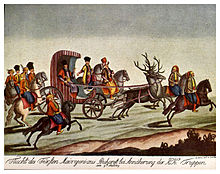
Deer have long had economic significance to humans. Deer meat, for which they are hunted and farmed, is called venison. Deer organ meat is called umble. See humble pie.
The Sami of Scandinavia and the Kola Peninsula of Russia and other nomadic peoples of northern Asia use reindeer for food, clothing, and transport.
The caribou in North America is not domesticated or herded as is the case of reindeer (the same species) in Europe, but is important as a quarry animal to the Inuit. Most commercial venison in the United States is imported from New Zealand.
Deer were originally brought to New Zealand by European settlers, and the deer population rose rapidly. This caused great environmental damage and was controlled by hunting and poisoning until the concept of deer farming developed in the 1960s. Deer farms in New Zealand number more than 3,500, with more than 400,000 deer in all.
Automobile collisions with deer can impose a significant cost on the economy. In the U.S., about 1.5 million deer-vehicle collisions occur each year, according to the National Highway Traffic Safety Administration. Those accidents cause about 150 deaths and $1.1 billion in property damage annually.[1]
Taxonomy
Note that the terms indicate the origin of the groups, not their modern distribution: the water deer, for example, is a New World species but is found only in China and Korea.
It is thought that the new world group evolved about 5 million years ago in the forests of North America and Siberia, the old world deer in Asia.
Subfamilies, genera and species
The family Cervidae is organized as follows:
- Subfamily Muntiacinae (Muntjacs)
- Genus Muntiacus:
- Southern Red Muntjac or Indian Muntjac (Muntiacus muntjak)
- Reeves's Muntjac or Chinese Muntjac (Muntiacus reevesi)
- Hairy-fronted Muntjac or Black Muntjac (Muntiacus crinifrons)
- Fea's Muntjac (Muntiacus feae)
- Bornean Yellow Muntjac (Muntiacus atherodes)
- Roosevelt's muntjac (Muntiacus rooseveltorum)
- Gongshan muntjac (Muntiacus gongshanensis)
- Giant Muntjac (Muntiacus vuquangensis)
- Truong Son Muntjac (Muntiacus truongsonensis)
- Leaf muntjac (Muntiacus putaoensis)
- Sumatran Muntjac (Muntiacus montanum)
- Pu Hoat Muntjac (Muntiacus puhoatensis)
- Genus Elaphodus:
- Tufted deer (Elaphodus cephalophus)
- Genus Muntiacus:
- Subfamily Cervinae (True Deer, Old World Deer):
- Genus Cervus:
- Subgenus Cervus:
- European red deer (Cervus elaphus)
- Central Asian Red Deer (Cervus wallichi)
- Elk (Cervus canadensis) (North American and Asian Elk; second largest deer in world; not to be confused with Moose, known as Elk in Europe)
- Subgenus Przewalskium:
- Thorold's deer, or white-lipped deer (Cervus albirostris)
- Subgenus Sika:
- Sika Deer (Cervus nippon)
- Subgenus Rucervus:
- Barasingha (Cervus duvaucelii)
- Schomburgk's Deer (Cervus schomburgki) (extinct, 1938)
- Eld's Deer or Thamin (Cervus eldii)
- Subgenus Rusa:
- Indian Sambar (Cervus unicolor)
- Sunda Sambar or Rusa Deer (Cervus timorensis)
- Philippine Sambar (Cervus mariannus)
- Philippine Spotted Deer or Visayan Spotted Deer (Cervus alfredi) (smallest Old World deer)
- Subgenus Cervus:
- Genus Axis:
- Subgenus Axis:
- Chital or Axis deer (Axis axis)
- Subgenus Hyelaphus:
- Hog Deer (Axis porcinus)
- Calamian Deer (Axis calamianensis)
- Bawean Deer (Axis kuhlii)
- Subgenus Axis:
- Genus Elaphurus:
- Père David's Deer (Elaphurus davidianus)
- Genus Dama:
- Fallow Deer (Dama dama)
- Persian fallow deer (Dama mesopotamica)
- Genus Megaloceros:
- Giant Deer (Megaloceros giganteus) †[3]
- Genus Cervus:

- Subfamily Hydropotinae (Water Deer)
- Genus Hydropotes:
- Chinese water deer (Hydropotes inermis)
- Genus Hydropotes:
- Subfamily Odocoileinae/Capreolinae (New World Deer)
- Genus Odocoileus:
- White-tailed deer (Odocoileus virginianus)
- Mule deer, or Black-tailed deer (Odocoileus hemionus)
- Genus Blastocerus:
- Marsh Deer (Blastocerus dichotomus)
- Genus Ozotoceros:
- Pampas deer (Ozotoceros bezoarticus)
- Genus Mazama:
- Red Brocket (Mazama americana)
- Merida Brocket (Mazama bricenii)
- Dwarf Brocket (Mazama chunyi)
- Gray Brocket (Mazama gouazoubira)
- Pygmy Brocket (Mazama nana)
- Yucatan Brown Brocket (Mazama pandora)
- Little Red Brocket (Mazama rufina)
- Genus Pudu:
- Northern Pudu (Pudu mephistophiles) (smallest deer in the world)
- Southern Pudú (Pudu pudu)
- Genus Hippocamelus:
- Taruca or North Andean Deer (Hippocamelus antisensis)
- Chilean Huemul or South Andean Deer (Hippocamelus bisulcus)
- Genus Capreolus:
- European Roe Deer (Capreolus capreolus)
- Siberian Roe Deer (Capreolus pygargus)
- Genus Rangifer:
- Caribou/Reindeer (Rangifer tarandus)
- Genus Alces:
- Moose (Alces alces; called "Elk" outside North America) (largest deer in the world)
- Genus Odocoileus:
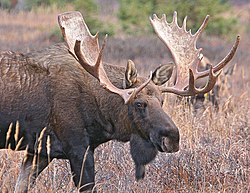
Hybrid deer
In On the Origin of Species (1859), Charles Darwin wrote "Although I do not know of any thoroughly well-authenticated cases of perfectly fertile hybrid animals, I have some reason to believe that the hybrids from Cervulus vaginalis and Reevesii [...] are perfectly fertile." These two varieties of muntjac are currently considered the same species.
A number of deer hybrids are bred to improve meat yield in farmed deer. American Elk (or Wapiti) and Red Deer from the Old World can produce fertile offspring in captivity, and were once considered one species. Hybrid offspring, however, must be able to escape and defend themselves against predators, and these hybrid offspring are unable to do so in the wild state. Recent DNA, animal behavior studies, and morphology and antler characteristics have shown there are not one but three species of Red Deer: European Red Deer, Central Asian Red Deer, and American Elk or Wapiti. The European Elk is a different species and is known as moose in North America. The hybrids are about 30% more efficient in producing antlers by comparing velvet to body weight. Wapiti have been introduced into some European Red Deer herds to improve the Red Deer type, but not always with the intended improvement.
In New Zealand, where deer are introduced species, there are hybrid zones between Red Deer and North American Wapiti populations and also between Red Deer and Sika Deer populations. In New Zealand, Red Deer have been artificially hybridized with Pere David Deer in order to create a farmed deer which gives birth in spring. The initial hybrids were created by artificial insemination and back-crossed to Red Deer. However, such hybrid offspring can only survive in captivity free of predators.
In Canada, the farming of European Red Deer and Red Deer hybrids is considered a threat to native Wapiti. In Britain, the introduced Sika Deer is considered a threat to native Red Deer. Initial Sika Deer/Red Deer hybrids occur when young Sika stags expand their range into established red deer areas and have no Sika hinds to mate with. They mate instead with young Red hinds and produce fertile hybrids. These hybrids mate with either Sika or Red Deer (depending which species is prevalent in the area), resulting in mongrelization. Many of the Sika Deer which escaped from British parks were probably already hybrids for this reason. These hybrids do not properly inherit survival strategies and can only survive in either a captive state or when there are no predators.
In captivity, Mule Deer have been mated to White-tail Deer. Both male Mule Deer/female White-tailed Deer and male White-tailed Deer/female Mule Deer matings have produced hybrids. Less than 50% of the hybrid fawns survived their first few months. Hybrids have been reported in the wild but are disadvantaged because they don't properly inherit survival strategies. Mule Deer move with bounding leaps (all 4 hooves hit the ground at once, also called "stotting") to escape predators. Stotting is so specialized that only 100% genetically pure Mule Deer seem able to do it. In captive hybrids, even a one-eighth White-tail/seven-eighths Mule Deer hybrid has an erratic escape behaviour and would be unlikely to survive to breeding age. Hybrids do survive on game ranches where both species are kept and where predators are controlled by man.
Cultural significance
Heraldry
Deer are represented in heraldry by the stag or hart (or less often by the hind). Stag's heads and antlers also appear as charges.
Examples can be found in the arms of Hertfordshire and its county town of Hertford, both examples of canting arms (a heraldic pun).
Several Norwegian municipalities have a stag or stag's head in their arms: Gjemnes, Hitra, Hjartdal, Rendalen and Voss.
A deer appears on the arms of the Israeli Postal Authority (see Hebrew Wikipedia page [2])
-
Arms of Raon aux Bois, France -
Arms of Dotternhausen, Germany -
Arms of Thierachern, Switzerland -
Arms of Friolzheim, Germany -
Arms of Bauen, Switzerland -
Arms of the Earls Bathurst
Literature and art
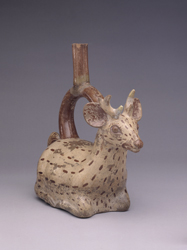



- For the role of deer in mythology, see deer in mythology.
- The "Golden Hind" was an English galleon best known for its global circumnavigation between 1577 and 1580, captained by Sir Francis Drake.
- The book Fire Bringer is a fiction book that is about a young fawn who is born and goes on a quest to save the deer kind who are called the Herla in the novel.
- In Christmas lore (such as in the narrative poem "A Visit from St. Nicholas"), reindeer are often depicted pulling the sleigh of Santa Claus.
- One famous fictional deer is Bambi. In the Disney film Bambi, he is a white-tailed deer, while in Felix Salten's original book Bambi, A Life in the Woods, he is a roe deer.
- The Pulitzer Prize-winning 1938 novel The Yearling, written by Marjorie Kinnan Rawlings, was about a boy's relationship with a baby deer, later adapted to a children's film that was nominated for an Academy Award for Best Picture.
- Saint Hubertus saw a stag with a crucifix between its antlers while hunting on Good Friday and was converted to Christianity by the vision.
- In the Harry Potter series, the Patronus Charm that Harry Potter conjures to repel Dementors is a silver stag. James Potter, Harry's father, had an Animagus form as a stag. Also, Harry's mother Lily Potter, and subsequently Severus Snape's, Patronus form was a doe.
- In one of the stories of Baron Munchhausen, the baron encounters a stag while eating cherries and without ammunition, fires the cherry-pits at the stag with his musket, but it escapes. The next year, the baron encounters a stag with a cherry tree growing from its head; presumably this is the animal he had shot at the previous year.
- A Samurai warrior named Honda Tadakatsu famously adorned deer antlers on his helmet.
- Deer have been a subject in Chinese paintings numerous times as a tranquility symbol.
- In The Animals of Farthing Wood, a deer called The Great White Stag is the leader of all the animal residents of the nature reserve White Deer Park.
- In The Queen, a 14 point "Imperial" stag plays a role in the film.
- The Yaqui deer song (maso bwikam) accompanies the deer dance which is performed by a pascola [from the Spanish 'pascua', Easter] dancer (also known as a deer dancer). Pascolas will perform at religio-social functions many times of the year, but especially during Lent and Easter.
- Deer are depicted in many materials by various pre-Hispanic civilizations in the Andes.[4]
- Several German towns are called "Hirschberg", a name composed of Hirsch (deer) and Berg (hill or mountain).
- The given name "Oscar" is considered to be derived from Gaelic, meaning "deer lover."
- Among East European Jews, "Hirsh"—Yiddish for "stag"—was a common male name, and was among other others the name of several prominent Rabbis; in this community there was, however, no equivalent female name. In contemporary Israel, several Hebrew names for this animal are commonly used as both male and female names. These include "Tzvi" (צבי) and "Eyal"(אייל)—two synonymous words for "stag"; "Tzviya" (צביה) and "Ayala" (איילה)—the respective parallel words for "Hind" or "Doe"; as well as "Ofer" (עופר) and "Ofra"(עפרה), respectively the male and female words for the young of this animal—which are all commonly used as first names among the Israeli population. In addition, there are Israelis having as their first name "Bambi", derived from the well-known Disney animated film.
Among the Tlingit Indians of S.E. Alaska the deer is a symbol of peace, because a deer doesn't bite, get angry and is gentle. When peace was to be made a "hostage" from opposing clans would be taken to the opposite clan of those making peace and each opposing faction would have a hostage, called Ghuwukaan in a ceremony lasting several months. The name for [Sitka Blacktail] deer is Ghuwukaan. Making peace is called Ghuwukaan Khuwdzitee or "there will be a peace party." A name given to the "hostage" by his captors would be with the term "ghuwukaan" added such as Aank'weiyi Ghuwukaan (Flag Deer) or Dzagitgayaa Ghuwukaan (Hummingbird Deer). [Haa Khusteeyi-Our Culture; Dauenhauer & Dauenhauer, 1994, UW Press]
See also
References
- ^ www.bartleby.com
- ^ Magna Britannica et Hibernia
- ^ The phylogenetic position of the 'giant deer' Megaloceros giganteus. Letter in Nature 438, 850–853 (8 December 2005)
- ^ Berrin, Katherine & Larco Museum. The Spirit of Ancient Peru:Treasures from the Museo Arqueológico Rafael Larco Herrera. New York: Thames and Hudson, 1997.


